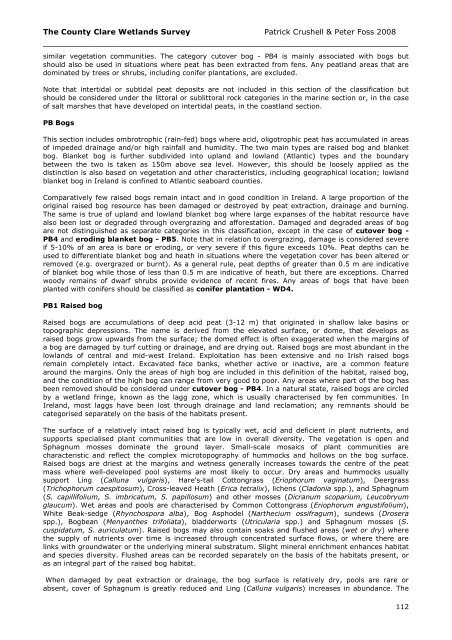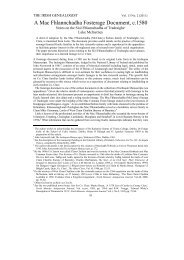Report Cover Vol I - Clare County Library
Report Cover Vol I - Clare County Library
Report Cover Vol I - Clare County Library
Create successful ePaper yourself
Turn your PDF publications into a flip-book with our unique Google optimized e-Paper software.
The <strong>County</strong> <strong>Clare</strong> Wetlands Survey Patrick Crushell & Peter Foss 2008<br />
_______________________________________________________________<br />
similar vegetation communities. The category cutover bog - PB4 is mainly associated with bogs but<br />
should also be used in situations where peat has been extracted from fens. Any peatland areas that are<br />
dominated by trees or shrubs, including conifer plantations, are excluded.<br />
Note that intertidal or subtidal peat deposits are not included in this section of the classification but<br />
should be considered under the littoral or sublittoral rock categories in the marine section or, in the case<br />
of salt marshes that have developed on intertidal peats, in the coastland section.<br />
PB Bogs<br />
This section includes ombrotrophic (rain-fed) bogs where acid, oligotrophic peat has accumulated in areas<br />
of impeded drainage and/or high rainfall and humidity. The two main types are raised bog and blanket<br />
bog. Blanket bog is further subdivided into upland and lowland (Atlantic) types and the boundary<br />
between the two is taken as 150m above sea level. However, this should be loosely applied as the<br />
distinction is also based on vegetation and other characteristics, including geographical location; lowland<br />
blanket bog in Ireland is confined to Atlantic seaboard counties.<br />
Comparatively few raised bogs remain intact and in good condition in Ireland. A large proportion of the<br />
original raised bog resource has been damaged or destroyed by peat extraction, drainage and burning.<br />
The same is true of upland and lowland blanket bog where large expanses of the habitat resource have<br />
also been lost or degraded through overgrazing and afforestation. Damaged and degraded areas of bog<br />
are not distinguished as separate categories in this classification, except in the case of cutover bog -<br />
PB4 and eroding blanket bog - PB5. Note that in relation to overgrazing, damage is considered severe<br />
if 5-10% of an area is bare or eroding, or very severe if this figure exceeds 10%. Peat depths can be<br />
used to differentiate blanket bog and heath in situations where the vegetation cover has been altered or<br />
removed (e.g. overgrazed or burnt). As a general rule, peat depths of greater than 0.5 m are indicative<br />
of blanket bog while those of less than 0.5 m are indicative of heath, but there are exceptions. Charred<br />
woody remains of dwarf shrubs provide evidence of recent fires. Any areas of bogs that have been<br />
planted with conifers should be classified as conifer plantation - WD4.<br />
PB1 Raised bog<br />
Raised bogs are accumulations of deep acid peat (3-12 m) that originated in shallow lake basins or<br />
topographic depressions. The name is derived from the elevated surface, or dome, that develops as<br />
raised bogs grow upwards from the surface; the domed effect is often exaggerated when the margins of<br />
a bog are damaged by turf cutting or drainage, and are drying out. Raised bogs are most abundant in the<br />
lowlands of central and mid-west Ireland. Exploitation has been extensive and no Irish raised bogs<br />
remain completely intact. Excavated face banks, whether active or inactive, are a common feature<br />
around the margins. Only the areas of high bog are included in this definition of the habitat, raised bog,<br />
and the condition of the high bog can range from very good to poor. Any areas where part of the bog has<br />
been removed should be considered under cutover bog - PB4. In a natural state, raised bogs are circled<br />
by a wetland fringe, known as the lagg zone, which is usually characterised by fen communities. In<br />
Ireland, most laggs have been lost through drainage and land reclamation; any remnants should be<br />
categorised separately on the basis of the habitats present.<br />
The surface of a relatively intact raised bog is typically wet, acid and deficient in plant nutrients, and<br />
supports specialised plant communities that are low in overall diversity. The vegetation is open and<br />
Sphagnum mosses dominate the ground layer. Small-scale mosaics of plant communities are<br />
characteristic and reflect the complex microtopography of hummocks and hollows on the bog surface.<br />
Raised bogs are driest at the margins and wetness generally increases towards the centre of the peat<br />
mass where well-developed pool systems are most likely to occur. Dry areas and hummocks usually<br />
support Ling (Calluna vulgaris), Hare's-tail Cottongrass (Eriophorum vaginatum), Deergrass<br />
(Trichophorum caespitosum), Cross-leaved Heath (Erica tetralix), lichens (Cladonia spp.), and Sphagnum<br />
(S. capillifolium, S. imbricatum, S. papillosum) and other mosses (Dicranum scoparium, Leucobryum<br />
glaucum). Wet areas and pools are characterised by Common Cottongrass (Eriophorum angustifolium),<br />
White Beak-sedge (Rhynchospora alba), Bog Asphodel (Narthecium ossifragum), sundews (Drosera<br />
spp.), Bogbean (Menyanthes trifoliata), bladderworts (Utricularia spp.) and Sphagnum mosses (S.<br />
cuspidatum, S. auriculatum). Raised bogs may also contain soaks and flushed areas (wet or dry) where<br />
the supply of nutrients over time is increased through concentrated surface flows, or where there are<br />
links with groundwater or the underlying mineral substratum. Slight mineral enrichment enhances habitat<br />
and species diversity. Flushed areas can be recorded separately on the basis of the habitats present, or<br />
as an integral part of the raised bog habitat.<br />
When damaged by peat extraction or drainage, the bog surface is relatively dry, pools are rare or<br />
absent, cover of Sphagnum is greatly reduced and Ling (Calluna vulgaris) increases in abundance. The<br />
112
















